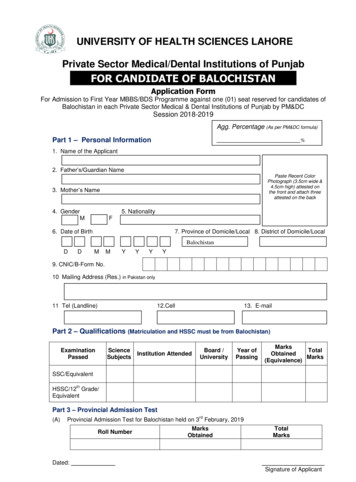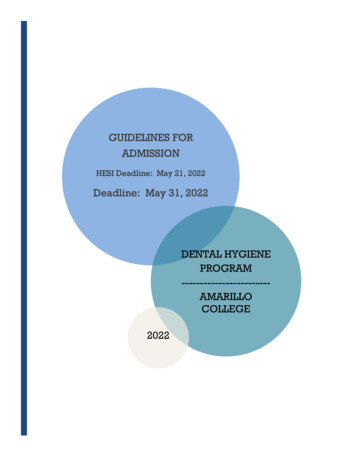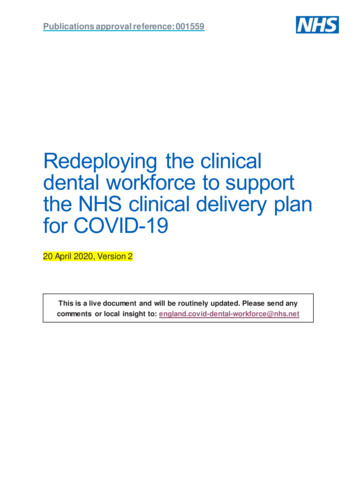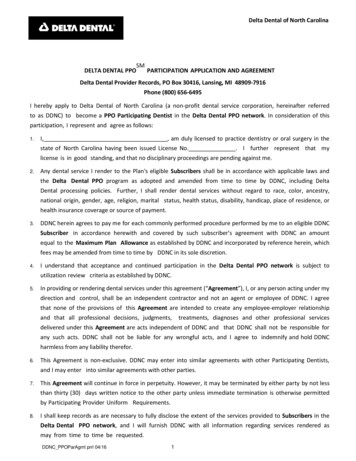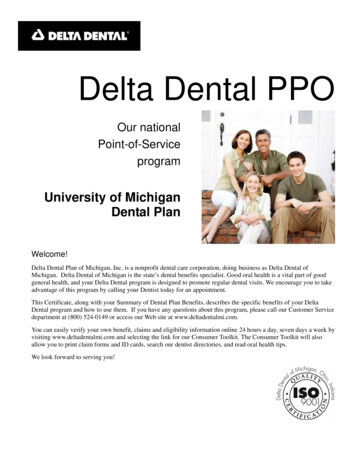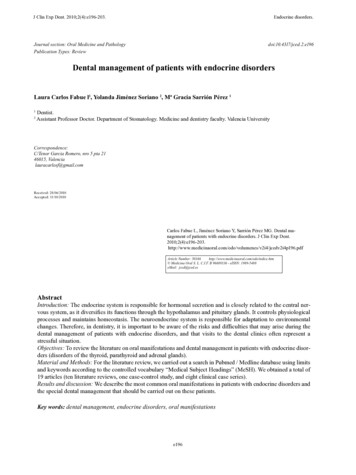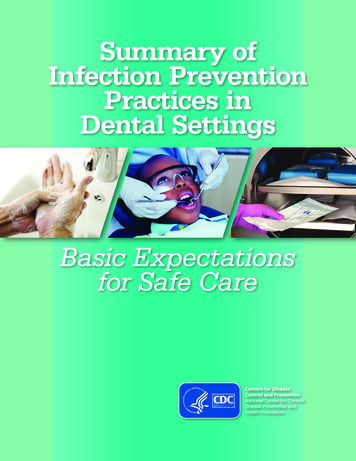
Transcription
J Clin Exp Dent. 2017;9(2):e289-93.Implications of dabigatran in dental treatmentsJournal section: Oral SurgeryPublication Types: 317/jced.53219Dental management of patients takingnovel oral anticoagulants (NOAs): DabigatranAdrian Curto, Alberto Albaladejo, Alfonso AlvaradoDepartment of Surgery, Faculty of Medicine, University of Salamanca, Salamanca, SpainCorrespondence:Faculty of Medicine-University of SalamancaAlfonso X El Sabio, s/n37007 – Salamanca, Spainadrian odonto@usal.esReceived: 09/05/2016Accepted: 22/05/2016Curto A, Albaladejo A, Alvarado A. Dental management of patientstaking novel oral anticoagulants (NOAs): Dabigatran. J Clin Exp /odo/volumenes/v9i2/jcedv9i2p289.pdfArticle Number: 53219http://www.medicinaoral.com/odo/indice.htm Medicina Oral S. L. C.I.F. B 96689336 - eISSN: 1989-5488eMail: jced@jced.esIndexed in:PubmedPubmed Central (PMC)ScopusDOI SystemAbstractBackground: A new group of oral anticoagulants (dabigatran, rivaroxaban, apixaban and edoxaban) with clearadvantages over classic dicoumarin oral anticoagulants (warfarin and acenocoumarol) has been developed in recent years. Patients being treated with oral anticoagulants are at higher risk for bleeding when undergoing dentaltreatments.Material and Methods: A literature search was conducted through April 2016 for publications in the ISI Web ofKnowledge, PubMed and Cochrane Library using the keywords “dabigatran”, “rivaroxaban”, “apixaban”, “edoxaban”, “new oral anticoagulants”, “novel oral anticoagulants”, “bleeding” and “dental treatment”.Results: There is no need for regular coagulation monitoring of patients on dabigatran therapy. Whether or not totemporarily discontinue dabigatran must be assessed according to the bleeding risk involved in the dental procedureto be performed.Conclusions: The number of patients under treatment with new oral anticoagulants will increase in the comingyears. It is essential to know about the pharmacokinetics and pharmacodynamics of new oral anticoagulants andabout their interactions with other drugs. It is necessary to develop clinical guidelines for the perioperative andpostoperative management of these new oral anticoagulants in oral surgical procedures, and to carefully evaluatethe bleeding risk of dental treatment, as well as the thrombotic risk of suppressing the new oral anticoagulant.Key words: Dabigatran, rivaroxaban, apixaban, edoxaban, novel oral anticoagulants, bleeding.IntroductionVitamin K antagonist anticoagulant drugs have been widely used for the treatment of nonvalvular atrial fibrillation. Atrial fibrillation is the first cause of embolism,regardless of whether it is associated to valve diseaseor not. For decades, it has been standardly treated withdicoumarin anticoagulants, mainly acenocoumarol andwarfarin (2). Their therapeutic window is narrow andThe number of patients under treatment with anticoagulant and antiplatelet drugs that require dental treatmenthas grown in recent years, so that there are many anticoagulated patients in our area. Oral anticoagulants andantiplatelet drugs are used for primary and secondaryprevention of venous thromboembolic diseases (1).e289
J Clin Exp Dent. 2017;9(2):e289-93.Implications of dabigatran in dental treatmentscomparison with classic Vitamin K antagonist anticoagulant drugs. In recent years, substances able to reversethe effect of new oral anticoagulants have been developed, among them idarucizumab (specific reversal agentof the anticoagulant effect of dabigatran), adexanet alfaand ciraparantag. In October 2015, the Food and DrugAdministration (FDA) approved the marketing of idarucizumab (Praxbind ) as an antidote to the anticoagulanteffect of dabigatran. Idarucizumab rapidly and completely reversed (within minutes) the anticoagulant activityof dabigatran in 88 to 98 % of patients in an initial clinical study. The approval of idarucizumab will substantially influence the approach to haemorrhagic complications related to dabigatran. It is worth noting that thereis currently scarce clinical experience in the use of thesenew substances (10).In economic terms, the cost of treatment with dabigatranis higher than with warfarin or acenocoumarol (11).patients require regular International Normalized Ratio(INR) monitoring. Vitamin K antagonist drugs showmany interactions with other drugs and with certainfood.The ideal oral anticoagulant should be safer and moreeffective than classic oral anticoagulants. In recentyears, research in the area of pharmacology has focusedon the development of new oral anticoagulants with awide therapeutic window, few drug-drug and food-druginteractions, low intraindividual variability and no needfor regular and systematic monitoring.The four new oral anticoagulants that have been developed and are currently marketed are dabigatran (Pradaxa ), rivaroxaban (Xarelto ), apixaban (Eliquis )and edoxaban (Lixiana ). Rivaroxaban, apixaban andedoxaban are direct Factor Xa inhibitors, while dabigatran is a direct thrombin inhibitor (3).The efficacy of dabigatran in the treatment of nonvalvular atrial fibrillation was assessed in 2009 in the RE-LYstudy, which compared the use of warfarin versus dabigatran using a sample of 18113 patients with nonvalvular atrial fibrillation. The study showed a reduction incardiovascular events in patients treated with dabigatranas compared to those taking warfarin (4,5).According to the European Medicines Agency (EMA),the dose of dabigatran for the prevention of stroke andsystemic embolism in patients with nonvalvular atrial fibrillation is between 110 and 150 mg taken orally every12 hours (6).Dabigatran exerts its anticoagulant effect through plasmatic binding to thrombin, thus deactivating it. It is apotent, selective, reversible and competitive thrombininhibitor, and its possibility to reach the clot and deactivate the thrombin is one of the advantages of these neworal anticoagulants.By inhibiting thrombin, dabigatran reduces the formation of fibrin, inhibits thrombin-mediated platelet activation and reduces fibrinolysis inhibition (7).After oral administration of dabigatran etexilate, it isquickly metabolized to its active form by esterases in theintestine. Plasma concentrations peak within 2 hours of itsadministration and decrease by half after 12 hours (8).Table 1 shows the pharmacological characteristics ofnew oral anticoagulants (9).A shortcoming that was noticed during the initial stagesof the development of these new drugs was the absence of antidotes to reverse their anticoagulant effect inMaterial and MethodsThe aim of this paper is to contribute to the discussionon how to approach patients taking dabigatran, before,during and after dental treatment in light of the morerecent knowledges.In the present contribution we offer an exhaustive reviewof the literature found in the ISI Web of Knowledge,PubMed and Cochrane Library in April 2016, includingarticles published in the last 10 years. The words usedwere “dabigatran”, “rivaroxaban”, “apixaban”, “edoxaban”, “new oral anticoagulants”, “novel oral anticoagulants”, “bleeding” and “dental treatment” with the “and”boolean operator.Results-Analytical tests:Regular routine monitoring of the anticoagulant effectof new oral anticoagulants is not required, although itis necessary to be aware of their anticoagulant effect inthe event of bleeding before starting invasive treatments.The effects of dabigatran can be quantified through different coagulation tests. New oral anticoagulants affectclassic analytical tests in a dose-dependent manner. Thisentails a change of perspective in laboratory tests relatedto the perioperative management of new oral anticoagulants with regard to classic oral anticoagulants (12).The ecarin clotting time, thrombin time and dilutedthrombin time are sensitive to dabigatran plasma con-Table 1. Pharmacological characteristics of new oral anPlasma protein binding3%Bioavailability6%Half-life15 hoursRenal excretion80%90%87%54%80%50%50%11 hours12 hours10 hours33%25%35%e290
J Clin Exp Dent. 2017;9(2):e289-93.Implications of dabigatran in dental treatmentscentrations. Prothrombin time and activated partialthromboplastin time show low sensitivity to dabigatran.The determination of anti-Xa concentrations is the mostspecific test to measure dabigatran plasma concentrations (13-16).-Dental management:Patients under treatment with oral anticoagulants are athigher risk for bleeding when undergoing invasive dental treatments (17).It may be necessary to temporarily discontinue dabigatran depending on the risk for bleeding involved in thedental treatment to be carried out and the patient’s renalfunction. Patients being treated with oral anticoagulantswho have impaired renal function are at higher risk forbleeding (the fact that approximately 80% of dabigatranis excreted via the kidneys should be taken into account)(18,19).Several studies have proved that the risk for bleedingof patients under treatment with new oral anticoagulantsis similar to that of patients being treated with warfarinwhen International Normalized Ratio (INR) values arebetween 2 and 3 (20,21).Based on the risk for bleeding involved, dental treatmentscan be classified into procedures with a low bleeding riskand procedures with medium or high bleeding risk.-Perioperative management in dental procedures withlow bleeding risk:Temporary discontinuation of dabigatran is not necessary prior to invasive dental procedures with low bleeding risk, which include simple exodontia, oral surgeryof up to 45 minutes and periodontal surgery with minimal bleeding risk (22-25). Hemostasis is to be facilitated, with local measures designed to help healing andminimize the risk of bleeding.-Perioperative management in dental procedures withmedium and high bleeding risk:These cases (multiple extractions 3, surgery lastingmore than 45 minutes and head cancer surgery) requirediscontinuation of dabigatran and the need to considersubcutaneous heparin as an alternative treatment. Therehas been controversy for years regarding the suspensionor alternation of anticoagulant therapy when planninginvasive dental treatments. The instructions to discontinue dabigatran should be consulted with the specialistphysician (26-29). Table 2 provides guidance for discontinuation of dabigatran.-Postoperative management in dental procedures:Management must be optimized from preoperative workup to the postoperative period in all patients subjectedto oral anticoagulant treatment.When to resume dabigatran depends on the extent towhich the patient’s haemostasis is satisfactory. Treatmentwith dabigatran should be restarted as soon as possible.In dental procedures with average or high bleeding risk,dabigatran can be restarted 24-48 hours after surgery(30,31).Local haemostatic measures such as sutures, gelatine orcellulose sponges, and tranexamic acid mouthwashesare required to help reduce the possibility of postoperative bleeding. Good soft tissue management is essentialin this sense, in order to avoid excessive traumatism ofthe surgical zone (32).The management of haemorrhagic complications in patients under treatment with dabigatran should be individualized according to the severity of the bleeding, thefirst step being to temporarily discontinue dabigatran.In cases of mild bleeding it is enough to stop the oralanticoagulant and use local haemostatic measures. In patients with renal insufficiency, the half-life of dabigatrancan increase, which may worsen bleeding (33,34).In moderate to serious bleeding it is essential to treat thepatient in a hospital. Haemodialysis treatment, administration of a transfusion of platelet concentrates, parenteral administration of antifibrinolytics or prothrombincomplex concentrates or recombinant factor VIIa is essential in cases of moderate to severe bleeding (35).-Drug interactions:Although dabigatran is not metabolized by the cytochrome P450 enzymes, it is a substrate of P-glycoprotein.This relationship defines the main interactions of dabigatran with other drugs.While dabigatran does not interact directly with nonsteroidal anti-inflammatory drugs (NSAIDs), these shouldbe prescribed with caution. It is preferable to administeranalgesics (36).Pharmacodynamic interactions with other antithromboticand antiplatelet agents have not been fully studied yet. Thecombined use of acetylsalicylic acid and dabigatran shouldbe avoided, since it increases the risk of bleeding (37).Proton pump inhibitors (omeprazole, esomeprazole, lansoprazole, rabeprazole, pantoprazole) slightly reduce theintestinal absorption of dabigatran (38).Table 2. Instructions to discontinue dabigatran in dental procedures with medium and high bleeding risk.Renal function (ClCr ml/min) 8050 - 8030 - 50 30Medium bleeding risk1 day before2 days before 48 hours2-5 days beforee291High bleeding risk2 days before3 days before4 days before5 days before
J Clin Exp Dent. 2017;9(2):e289-93.Implications of dabigatran in dental treatmentsThe use of erythromycin and clarithromycin should beavoided because of their interaction with the effect ofdabigatran (39). This is also the case with rifampicin,which reduces dabigatran plasma concentrations (40).13. Cuker A, Siegal D. Monitoring and reversal of direct oral anticoagulants. Hematology Am Soc Hematol Educ Program. 2015;2015:11724.14. Gosselin RC, Dwyre DM, Dager WE. Measuring dabigatran concentrations using a chromogenic ecarin clotting time assay. Ann Pharmacother. 2013;47:1635-40.15. Dager WE, Gosselin RC, Kitchen S, Dwyre D. Dabigatran effectson the international normalized ratio, activated partial thromboplastintime, thrombin time, and fibrinogen: a multicenter, in vitro study. AnnPharmacother. 2012;46:1627-36.16. Avecilla ST, Ferrell C, Chandler WL, Reyes M. Plasma-dilutedthrombin time to measure dabigatran concentrations during dabigatranetexilate therapy. Am J Clin Pathol. 2012;137:572-4.17. Perry DJ, Noakes TJ, Helliwell PS; British Dental Society. Guidelines for the management of patients on oral anticoagulants requiringdental surgery. Br Dent J. 2007;203:389-93.18. O’Connell JE, Stassen LF. New oral anticoagulants and their implications for dental patients. J Ir Dent Assoc. 2014;60:137-43.19. Limdi NA, Limdi MA, Cavallari L, Anderson AM, Crowley MR,Baird MF, et al. Warfarin dosing in patients with impaired kidneyfunction. Am J Kidney Dis. 2010;56:823-31.20. Healey JS, Eikelboom J, Douketis J, Wallentin L, Oldgren J, YangS, et al. Periprocedural bleeding and thromboembolic events with dabigatran compared with warfarin: results from the Randomized Evaluation of Long-Term Anticoagulation Therapy (RE-LY) randomizedtrial. Circulation. 2012;126:343-8.21. Connolly SJ, Ezekowitz MD, Yusuf S, Eikelboom J, Oldgren J,Parekh A, et al. Dabigatran versus warfarin in patients with atrial fibrillation. N Engl J Med. 2009;361:1139-51.22. Elad S, Marshall J, Meyerowitz C, Connolly G. Novel anticoagulants: general overview and practical considerations for dental practitioners. Oral Dis. 2016;22:23-32.23. Johnston S. A New Generation of Antiplatelet, and AnticoagulantMedication and the Implications for the Dental Surgeon. Dent Update.2015;42:840-2.24. Scott A, Gibson J, Crighton A. The management of dental patientstaking new generation oral anticoagulants. Prim Dent J. 2014;3:54-8.25. Tsolka P. Dental Procedures in Patients with Atrial Fibrillation and New Oral Anticoagulants. Arrhythm Electrophysiol Rev.2014;3:85-9.26. Hong CH, Islam I. Anti-Thrombotic Therapy: Implications for Invasive Outpatient Procedures in Dentistry. J Blood Disorders Transf.2013;4:166.27. van Diermen DE, van der Waal I, Hoogstraten J. Managementrecommendations for invasive dental treatment in patients using oralantithrombotic medication, including novel oral anticoagulants. OralSurg Oral Med Oral Pathol Oral Radiol. 2013;116:709-16.28. Spyropoulos AC, Douketis JD. How I treat anticoagulated patients undergoing an elective pro-cedure or surgery. Blood. 2012;120:2954-62.29. Crowther MA, Warkentin TE. Bleeding risk and the managementof bleeding complications in patients undergoing anticoagulant therapy: focus on new anticoagulant agents. Blood. 2008;111:4871-9.30. Breik O, Cheng A, Sambrook P, Goss A. Protocol in managing oralsurgical patients taking dabigatran. Aust Dent J. 2014;59:296-301.31. Curtin C, Hayes JM, Hayes J. Dental implications of new oral anticoagulants for atrial fibrillation. Dent Update. 2014;41:526-8,530-1.32. Bacci C, Maglione M, Favero L, Perini A, Di Lenarda R, BerengoM, et al. Management of dental extraction in patients undergoing anticoagulant treatment. Results from a large, multicentre, prospective,case–control study. Thromb Haemost. 2010;104:972-5.33. Breik O, Tadros R, Devitt P. Thrombin inhibitors: surgical considerations and pharmacology. ANZ J Surg. 2013;83:215-21.34. van Ryn J, Stangier J, Haertter S, Liesenfeld KH, Wienen W,Feuring M, et al. Dabigatran etexilate--a novel, reversible, oral directthrombin inhibitor: interpretation of coagulation assays and reversal ofanticoagulant activity. Thromb Haemost. 2010;103:1116-27.35. Crowther MA, Warkentin TE. Managing bleeding in anticoagulated patients with a focus on novel therapeutic agents. J Thromb Haemost. 2009;7:107-10.ConclusionsThe number of patients under treatment with new oralanticoagulants around us is increasing.Dabigatran is a valid alternative to vitamin K antagonists for oral anticoagulation in patients with nonvalvular atrial fibrillation.Health professionals should be aware of the pharmacokinetics and pharmacodynamics of new oral anticoagulants, and it is necessary to establish clinical guidelinesfor the perioperative and postoperative management ofdental patients being treated with these new drugs.References1. Falck-Ytter Y, Francis CW, Johanson NA, Curley C, Dahl OE,Schulman S, et al. Prevention of VTE in Orthopedic Surgery Patients:Antithrombotic Therapy and Prevention of Thrombosis, 9th ed: American College of Chest Physicians Evidence-Based Clinical PracticeGuidelines. Chest. 2012;141(2 Suppl):e278S-325S.2. Laupacis A, Albers G, Dalen J, Dunn MI, Jacobson AK, Singer DE.The Evolving Consensus. Antithrombotic therapy in Atrial Fibrillation. Chest. 1998;114:579-89.3. Lip GY, Mitchell SA, Liu X, Liu LZ, Phatak H, Kachroo S, et al.Relative efficacy and safety of non-Vitamin K oral anticoagulantsfor non-valvular atrial fibrillation: Network meta-analysis comparing apixaban, dabigatran, rivaroxaban and edoxaban in three patientsubgroups. Int J Cardiol. 2016;204:88-94.4. Wallentin L, Yusuf S, Ezekowitz MD, Alings M, Flather M, Franzosi MG, et al. Efficacy and safety of dabigatran compared with warfarinat different levels of international normalised ratio control for strokeprevention in atrial fibrillation: an analysis of the RE-LY trial. Lancet.2010;376:975-83.5. Hohnloser SH, Oldgren J, Yang S, Wallentin L, Ezekowitz M, Reilly P, et al. Myocardial ischemic events in patients with atrial fibrillation treated with dabigatran or warfarin in the RE-LY (RandomizedEvaluation of Long-Term Anticoagulation Therapy) trial. Circulation.2012;125:669-76.6. Clemens A, Peng S, Brand S, Brueckmann M, Kansal A, Lim J,et al. Efficacy and cost-effectiveness of dabigatran etexilate versuswarfarin in atrial fibrillation in different age subgroups. Am J Cardiol.2014;114:849-55.7. Huntington JA, Baglin TP. Targeting thrombin--rational drug designfrom natural mechanisms. Trends Pharmacol Sci. 2003;24:589-95.8. Blech S, Ebner T, Ludwig-Schwellinger E, Stangier J, Roth W. Themetabolism and disposition of the oral direct thrombin inhibitor, dabigatran, in humans. Drug Metab Dispos. 2008;36:386-99.9. Eriksson BI, Quinlan DJ, Weitz JI. Comparative pharmacodynamicsand pharmacokinetics of oral direct thrombin and factor Xa inhibitorsin development. Clin Pharmacokinet. 2009;48:1-22.10. Hu TY, Vaidya VR, Asirvatham SJ. Reversing anticoagulant effectsof novel oral anticoagulants: role of ciraparantag, andexanet alfa, andidarucizumab. Vasc Health Risk Manag. 2016;12:35-44.11. van Leent MW, Stevanović J, Jansman FG, Beinema MJ, BrouwersJR, Postma MJ. Cost-Effectiveness of Dabigatran Compared to Vitamin-K Antagonists for the Treatment of Deep Venous Thrombosis in theNetherlands Using Real-World Data. PLoS One. 2015;10:e0135054.12. Pengo V, Crippa L, Falanga A, Finazzi G, Marongiu F, Palareti G,et al. Questions and answers on the use of dabigatran and perspectiveson the use of other new oral anticoagulants in patients with atrial fibrillation. A consensus document of the Italian Federation of ThrombosisCenters (FCSA). Thromb Haemost. 2011;106:868-76.e292
J Clin Exp Dent. 2017;9(2):e289-93.Implications of dabigatran in dental treatments36. Davis C, Robertson C, Shivakumar S, Lee M. Implications of Dabigatran, a direct thrombin inhibitor, for oral surgery practice. J CanDent Assoc. 2013;79:d74.37. Eikelboom JW, Wallentin L, Connolly SJ, Ezekowitz M, Healey JS,Oldgren J, et al. Risk of bleeding with 2 doses of dabigatran comparedwith warfarin in older and younger patients with atrial fibrillation: ananalysis of the randomized evaluation of long-term anticoagulant therapy (RE-LY) trial. Circulation. 2011;123:2363-72.38. Stangier J, Rathgen K, Stähle H, Gansser D, Roth W. The pharmacokinetics, pharmacodynamics and tolerability of dabigatran etexilate,a new oral direct thrombin inhibitor, in healthy male subjects. Br J ClinPharmacol. 2007;64:292-303.39. Firriolo FJ, Hupp WS. Beyond warfarin: the new generation of oralanticoagulants and their implications for the management of dental patients. Oral Surg Oral Med Oral Pathol Oral Radiol. 2012;113:43141.40. Hankey GJ, Eikelboom JW. Dabigatran etexilate: a new oralthrombin inhibitor. Circulation. 2011;123:1436-50.Conflict of InterestThe authors declare that there is no conflict of interests regarding thepublication of this paper.e293
Pharmacological characteristics of new oral anticoagulants. comparison with classic Vitamin K antagonist anticoa-gulant drugs. In recent years, substances able to reverse the effect of new oral anticoagulants have been develo-ped, among them idarucizumab (specific reversal agent of the anticoagulant effect of dabigatran), adexanet alfa


